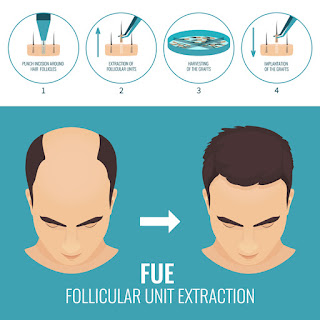Follicular Unit Extraction vs. Older Methods of Hair Transplantation
Before, as the names of these prior strategies show, going through a hair relocate was an agonizingly unsavory cycle. Men with retreating hairlines and going bald scalps frequently depended on the unnatural-looking, and regularly disparaged, hairpiece to stay away from the torment, moderate mending, and scarring of a transfer.
Along these lines, the hair relocate business was faltering in the late 20th century. Specialists realized that hair rebuilding procedures expected to develop.
Quick forward into the start of the twenty-first century...
A great many awful bald spots and strip entry point scars later, the new strategy that hair rebuilding specialists were sitting tight for was at long last culminated. The hair relocate local area at last accepted follicular unit extraction (FUE). Specialists commended the strategy and potential patients were interested about it.
Be that as it may, what precisely is follicular unit extraction? Furthermore, is it truly more successful and valuable than more established techniques for hair transplantation?
Follicular unit extraction includes the evacuation of little gatherings of hair follicles (generally somewhere in the range of one and four) from the benefactor site and their reinsertion into the receptor site. These little unites take into account equivalent dissemination of hair in the thinning up top zone of the scalp and produce more normal looking outcomes. Indeed, when the receptor site has totally mended, it is practically difficult to distinguish that such a hair relocate methodology has occurred.
The contrasts among FUE and the more seasoned techniques for transplantation are significant.
Initially, the FUE method is speedier and less difficult than some other hair reclamation procedure. FUE is performed with a punch-like surgical tool that cuts the skin around the follicle. This encourages the expulsion of around one to four follicles from the benefactor zone simultaneously. Likewise, the high level technique for follicular perforation(TM) permits the specialist to make a shallow punch on the encompassing tissue, guaranteeing that the join be delivered from the tissue with least footing and effortlessly. The extricated follicles (called joins) are then embedded into little cuts that have been cut in the beneficiary region. These cuts needn't bother with stitching, recuperate rapidly, and are totally imperceptible once the new hair starts to fill in around seven to ten days.
Furthermore, FUE is helpful on the grounds that the recuperation cycle is a lot quicker and less difficult. In many patients, the unions become completely secure in around eight days after medical procedure and the careful injury in the giver territory ordinarily recuperates inside one to about fourteen days. Some uneasiness might be available, however normally analgesics like Tylenol or codeine will help. By and large, ordinary movement might be continued one to about fourteen days after the method. In more established techniques for hair reclamation, dying, stitching, and wrapping were portions of the long and agonizing recuperation measure.
Thirdly, 100% of going bald victims are possibility for FUE. Before, hair rebuilding was not as generally accessible to each balding victim as it is today. There were different measures that every up-and-comer needed to meet to be qualified for a hair relocate. Such rules incorporated the patient's age, shading and surface of hair, skin composition, measure of giver hair accessible, and future going bald projections. Be that as it may, in light of the fact that the strategies associated with follicular unit extraction are so exceptional, such standards are a sorry concern. For instance, the measure of giver hair on the head isn't an issue while deciding appointment in light of the fact that the method considers the extraction of hair from different pieces of the body.
Fourthly, the occurrence of entanglement during the FUE strategy is lower than with other transplantation techniques. In an investigation, distributed by Dr. Masumi Inaba, of more than 150 patients treated with FUE, specialists found that patients experienced just gentle inconvenience from standing by for a few hours all at once. Moreover, just four out of the 150 patients experienced contributor zone stun, while two additional patients encountered a more restricted assortment of inconsistent roundabout alopecia (balding). All things considered, all patients made full recuperations inside five weeks.
Ultimately, FUE patients recuperate without obvious scars in the giver or beneficiary zone. In contrast to past techniques, similar to strip entry point, where an ugly straight scar was uncovered in the giver territory, FUE doesn't leave revolting, unendurable scars on the head. All things being equal, the little cuts that are trimmed in the beneficiary region are advantageously covered up by new hair. The end-product of FUE on the whole patients is that of a consistent, common, sound looking head of hair.
For each one of the individuals who are experiencing going bald and are looking for the best technique for reestablishing their childhood, FUE Hair Transplant ought to be thought of. It is a hair rebuilding strategy that disposes of the utilization of the difficult direct contributor entry point and respects 100% of going bald patients as legitimate contender for the methodology. It is broadly anticipated that inside the coming years, FUE Hair Transplant will make further headways and become the strategy for decision for each hair rebuilding specialist and patient.



Comments
Post a Comment